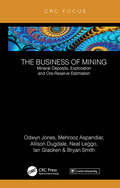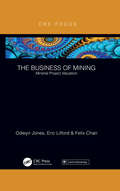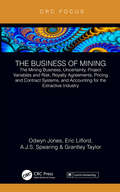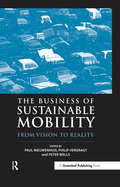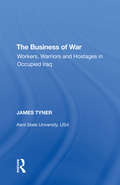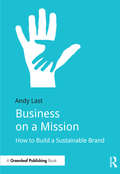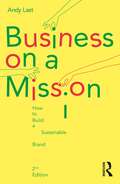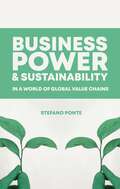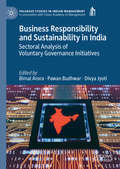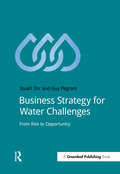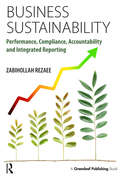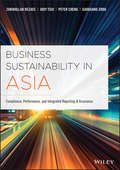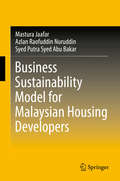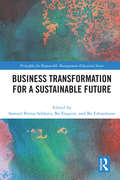- Table View
- List View
The Business of Mining: Mineral Deposits, Exploration and Ore-Reserve Estimation (Volume 3) (The Business of Mining)
by Ifan Odwyn Jones Mehrooz Aspandiar Allison Dugdale Neal Leggo Ian Glacken Bryan SmithThe Business of Mining complete set of three Focus books provides readers with a holistic all-embracing appraisal of the analytical tools available for assessing the economic viability of prospective mines. Each volume has a discrete focus. This third volume commences with "Our Earth, its Minerals and Ore Bodies", followed by a review of mineral exploration and sampling of mineral deposits. It continues with detailed sections covering the reporting of mineral resources and reserves in Australia, and concludes with the basic principles and application of the various methods of estimating the in-situ mineral resources and ore reserves. The books were written primarily for undergraduate applied geologists, mining engineers and extractive metallurgists and those pursuing course-based postgraduate programs in mineral economics. However, the complete series will also be an extremely useful reference text for practicing mining professionals as well as for consultant geologists, mining engineers or primary metallurgists.
The Business of Mining: Mineral Deposits, Exploration and Ore-Reserve Estimation (Volume 3) (The Business of Mining)
by Ifan Odwyn Jones Mehrooz Aspandiar Allison Dugdale Neal Leggo Ian Glacken Bryan SmithThe Business of Mining complete set of three Focus books provides readers with a holistic all-embracing appraisal of the analytical tools available for assessing the economic viability of prospective mines. Each volume has a discrete focus. This third volume commences with "Our Earth, its Minerals and Ore Bodies", followed by a review of mineral exploration and sampling of mineral deposits. It continues with detailed sections covering the reporting of mineral resources and reserves in Australia, and concludes with the basic principles and application of the various methods of estimating the in-situ mineral resources and ore reserves. The books were written primarily for undergraduate applied geologists, mining engineers and extractive metallurgists and those pursuing course-based postgraduate programs in mineral economics. However, the complete series will also be an extremely useful reference text for practicing mining professionals as well as for consultant geologists, mining engineers or primary metallurgists.
The Business of Mining: Mineral Project Valuation (The Business of Mining)
by Odwyn Jones Eric Lilford Felix ChanThe Business of Mining complete set of three Focus books will provide readers with a holistic all-embracing appraisal of the analytical tools available for assessing the economic viability of prospective mines. Each volume has a discrete focus. This second volume discusses, in some depth, alternative means of assessing the economic viability of mining projects based on the best estimate of the recoverable mineral and/or fossil fuel reserves. The books were written primarily for undergraduate applied geologists, mining engineers and extractive metallurgists and those pursuing course-based postgraduate programs in mineral economics. However, the complete series will also be an extremely useful reference text for practicing mining professionals as well as for consultant geologists, mining engineers or primary metallurgists.
The Business of Mining: Mineral Project Valuation (The Business of Mining)
by Odwyn Jones Eric Lilford Felix ChanThe Business of Mining complete set of three Focus books will provide readers with a holistic all-embracing appraisal of the analytical tools available for assessing the economic viability of prospective mines. Each volume has a discrete focus. This second volume discusses, in some depth, alternative means of assessing the economic viability of mining projects based on the best estimate of the recoverable mineral and/or fossil fuel reserves. The books were written primarily for undergraduate applied geologists, mining engineers and extractive metallurgists and those pursuing course-based postgraduate programs in mineral economics. However, the complete series will also be an extremely useful reference text for practicing mining professionals as well as for consultant geologists, mining engineers or primary metallurgists.
The Business of Mining: The Mining Business, Uncertainty, Project Variables and Risk, Royalty Agreements, Pricing and Contract Systems, and Accounting for the Extractive Industry (The Business of Mining)
by Odwyn Jones Eric Lilford Sam Spearing Grantley TaylorThe Business of Mining complete set of three Focus books will provide readers with a holistic all-embracing appraisal of the analytical tools available for assessing the economic viability of prospective mines. Each volume has a discrete focus. This first volume presents an overview of the mining business, followed by an analysis of project variables and risk, an overall coverage of the royalty agreements, pricing and contract systems followed by a final chapter on accounting standards and practises for the minerals industry. The books were written primarily for undergraduate applied geologists, mining engineers and extractive metallurgists and those pursuing course-based postgraduate programs in mineral economics. However, the complete series will also be an extremely useful reference text for practicing mining professionals as well as for consultant geologists, mining engineers or primary metallurgists.
The Business of Mining: The Mining Business, Uncertainty, Project Variables and Risk, Royalty Agreements, Pricing and Contract Systems, and Accounting for the Extractive Industry (The Business of Mining)
by Odwyn Jones Eric Lilford Sam Spearing Grantley TaylorThe Business of Mining complete set of three Focus books will provide readers with a holistic all-embracing appraisal of the analytical tools available for assessing the economic viability of prospective mines. Each volume has a discrete focus. This first volume presents an overview of the mining business, followed by an analysis of project variables and risk, an overall coverage of the royalty agreements, pricing and contract systems followed by a final chapter on accounting standards and practises for the minerals industry. The books were written primarily for undergraduate applied geologists, mining engineers and extractive metallurgists and those pursuing course-based postgraduate programs in mineral economics. However, the complete series will also be an extremely useful reference text for practicing mining professionals as well as for consultant geologists, mining engineers or primary metallurgists.
The Business of Sustainable Mobility: From Vision to Reality
by Peter Wells Paul Nieuwenhuis Philip VergragtIn many parts of the world, there is a crisis of mobility. The choices we have made over the past 200 years on modes and technologies of transport have brought us unprecedented global interaction and in many respects increased personal freedom. However, all this mobility has come at a cost to society, to the economy and to the environment. Mobility is in crisis, but few seem aware of the full extent of it. Though most people will be aware of congestion, accidents (although this aspect is often overlooked), parking restrictions or fuel prices, few will have considered the effects of the dramatic increase in mobility expected in China, India and elsewhere. Nor do many people in their daily lives consider the impact of climate change on our environment and the contribution our cars make to it. It is often thought that technology alone can solve this problem. For some observers, salvation could be achieved by means of hydrogen fuel cells, by hybrid cars, or by increased fuel efficiency, or even by telematics to reduce congestion. This book shows that "technology" may well not be enough in itself and that for a genuinely sustainable transport future far more radical change – affecting many aspects of society – is needed. It is likely, for example, that new business models are needed, as well as users and consumers adopting new forms of behaviour. Disruptive technological innovation may well contribute, but needs to be induced by a combination of market forces and government regulation.Many studies touch on transport and mobility issues and more mainstream books aimed at challenging the dominance of automobility are common, yet works dealing with the longer-term strategic, theoretical and broader conceptual issues needed to inform the move towards more sustainable transport are rare. Yet policy-makers, practitioners, as well as many sections of academia, acknowledge a need for guidance on new thinking on sustainable mobility. This book brings together a range of views representing both leading-edge thinking and best practice in the mobility sector. The individual expert contributions form the basis for framing a broader vision of future mobility and proposed transition trajectories towards that future.Much of the effort reflected in the chapters in this book is concerned with going beyond the "technofix" of new cars, to confront the more difficult challenges of institutional, cultural and social change within and beyond the industry that have to be resolved in the transition towards sustainability. It therefore seeks to break through the conventional boundary between engineering and the social sciences, and the contributors come from both sides of this traditional but unnecessary divide, combining economists, engineers, geographers, designers and others.The work is based on the sustainable mobility stream in the 2003 International Greening of Industry Network conference in San Francisco. This event brought together experts from industry and government, and the book combines some of the papers presented there, developed and updated into full chapters, with a number of additional chapters to capture some of the themes that emerged from the conference.The central problem addressed in this book is the private car: how to power it, how to build it and how to deliver it to customers in a more sustainable future. It starts with ideas of radical innovation in the propulsion system of the car, notably the hydrogen fuel cell. In one section, the book examines business models that could be used to deliver automobility in a more sustainable manner. This section looks at how the car is made and used, and looks beyond it by examining how we could change those aspects in our quest for sustainable mobility. The book then considers a number of recently introduced vehicles and alternative vehicle concepts within the context of a dominant existing paradigm. These vary from a minimalist single-seat commuter to a powertrain exchange concept that could breathe new life into the electric vehicle. A number of chapters then report on current practice
The Business of Sustainable Mobility: From Vision to Reality
by Peter Wells Paul Nieuwenhuis Philip VergragtIn many parts of the world, there is a crisis of mobility. The choices we have made over the past 200 years on modes and technologies of transport have brought us unprecedented global interaction and in many respects increased personal freedom. However, all this mobility has come at a cost to society, to the economy and to the environment. Mobility is in crisis, but few seem aware of the full extent of it. Though most people will be aware of congestion, accidents (although this aspect is often overlooked), parking restrictions or fuel prices, few will have considered the effects of the dramatic increase in mobility expected in China, India and elsewhere. Nor do many people in their daily lives consider the impact of climate change on our environment and the contribution our cars make to it. It is often thought that technology alone can solve this problem. For some observers, salvation could be achieved by means of hydrogen fuel cells, by hybrid cars, or by increased fuel efficiency, or even by telematics to reduce congestion. This book shows that "technology" may well not be enough in itself and that for a genuinely sustainable transport future far more radical change – affecting many aspects of society – is needed. It is likely, for example, that new business models are needed, as well as users and consumers adopting new forms of behaviour. Disruptive technological innovation may well contribute, but needs to be induced by a combination of market forces and government regulation.Many studies touch on transport and mobility issues and more mainstream books aimed at challenging the dominance of automobility are common, yet works dealing with the longer-term strategic, theoretical and broader conceptual issues needed to inform the move towards more sustainable transport are rare. Yet policy-makers, practitioners, as well as many sections of academia, acknowledge a need for guidance on new thinking on sustainable mobility. This book brings together a range of views representing both leading-edge thinking and best practice in the mobility sector. The individual expert contributions form the basis for framing a broader vision of future mobility and proposed transition trajectories towards that future.Much of the effort reflected in the chapters in this book is concerned with going beyond the "technofix" of new cars, to confront the more difficult challenges of institutional, cultural and social change within and beyond the industry that have to be resolved in the transition towards sustainability. It therefore seeks to break through the conventional boundary between engineering and the social sciences, and the contributors come from both sides of this traditional but unnecessary divide, combining economists, engineers, geographers, designers and others.The work is based on the sustainable mobility stream in the 2003 International Greening of Industry Network conference in San Francisco. This event brought together experts from industry and government, and the book combines some of the papers presented there, developed and updated into full chapters, with a number of additional chapters to capture some of the themes that emerged from the conference.The central problem addressed in this book is the private car: how to power it, how to build it and how to deliver it to customers in a more sustainable future. It starts with ideas of radical innovation in the propulsion system of the car, notably the hydrogen fuel cell. In one section, the book examines business models that could be used to deliver automobility in a more sustainable manner. This section looks at how the car is made and used, and looks beyond it by examining how we could change those aspects in our quest for sustainable mobility. The book then considers a number of recently introduced vehicles and alternative vehicle concepts within the context of a dominant existing paradigm. These vary from a minimalist single-seat commuter to a powertrain exchange concept that could breathe new life into the electric vehicle. A number of chapters then report on current practice
The Business of War: Workers, Warriors and Hostages in Occupied Iraq
by James A. TynerSince the cessation of major combat operations in Iraq, approximately 120 people - either contract workers or private soldiers - have been abducted, with one-third being executed. The largest contingent of these workers has been provided by the Philippines. Through a specific, though not exclusive, focus on the Philippines connection, this book considers the myriad ways in which transnational labour migration intersects with the occupation of Iraq. Also examining the role of the USA in the Middle East, the book places the war on terror within the practices of neoliberalism, but also links this with migration issues and argues that it is all part of a larger 'business' of conflict.
The Business of War: Workers, Warriors and Hostages in Occupied Iraq
by James A. TynerSince the cessation of major combat operations in Iraq, approximately 120 people - either contract workers or private soldiers - have been abducted, with one-third being executed. The largest contingent of these workers has been provided by the Philippines. Through a specific, though not exclusive, focus on the Philippines connection, this book considers the myriad ways in which transnational labour migration intersects with the occupation of Iraq. Also examining the role of the USA in the Middle East, the book places the war on terror within the practices of neoliberalism, but also links this with migration issues and argues that it is all part of a larger 'business' of conflict.
Business on a Mission: How to Build a Sustainable Brand
by Andy LastBronze winner of the AXIOM Business Book Award in the category of Philanthropy, Non-Profit, Sustainability. Please see: http://www.axiomawards.com/77/award-winners/2017-winners This easy-to-read and engaging book is the perfect introduction to how to build a sustainable brand for your organization. Intended as a roadmap that can be readily applied by busy managers and practitioners, the book includes interviews with business leaders, including Paul Polman of Unilever, Adam Elman of Marks & Spencer, and Jonas Prising of ManpowerGroup to provide insight into best practice and clear guidance for implementation. Throughout, the book avoids jargon and theorizing to ensure readability. Business on a Mission is based on more than a decade working with some of the first businesses to develop social missions and shows the foundations behind their success. It looks at how businesses can profit from working hand in hand with society and identifies a model for success. The book demonstrates how businesses can go from hiding behind "social shields" to picking up "social swords" and presents the six criteria to look for in assessing a social mission. It also focuses on how good communications can build trust and bring about positive change; and it provides clear ways to engage employees and improve productivity as well as "rules" for communicating social missions externally. This optimistic book explains the benefits of partnerships in the sustainable development agenda, particularly between businesses and NGOs. The book features guidelines for avoiding dysfunctional partnerships, and presents interviews with Marc Van Ameringen, Executive Director of GAIN (Global Alliance for Improved Nutrition) 2005 to 2016, and Myriam Sidibe, Social Mission Director for Africa, Unilever, on how things can be managed to the benefit of both partners. .
Business on a Mission: How to Build a Sustainable Brand
by Andy LastBronze winner of the AXIOM Business Book Award in the category of Philanthropy, Non-Profit, Sustainability. Please see: http://www.axiomawards.com/77/award-winners/2017-winners This easy-to-read and engaging book is the perfect introduction to how to build a sustainable brand for your organization. Intended as a roadmap that can be readily applied by busy managers and practitioners, the book includes interviews with business leaders, including Paul Polman of Unilever, Adam Elman of Marks & Spencer, and Jonas Prising of ManpowerGroup to provide insight into best practice and clear guidance for implementation. Throughout, the book avoids jargon and theorizing to ensure readability. Business on a Mission is based on more than a decade working with some of the first businesses to develop social missions and shows the foundations behind their success. It looks at how businesses can profit from working hand in hand with society and identifies a model for success. The book demonstrates how businesses can go from hiding behind "social shields" to picking up "social swords" and presents the six criteria to look for in assessing a social mission. It also focuses on how good communications can build trust and bring about positive change; and it provides clear ways to engage employees and improve productivity as well as "rules" for communicating social missions externally. This optimistic book explains the benefits of partnerships in the sustainable development agenda, particularly between businesses and NGOs. The book features guidelines for avoiding dysfunctional partnerships, and presents interviews with Marc Van Ameringen, Executive Director of GAIN (Global Alliance for Improved Nutrition) 2005 to 2016, and Myriam Sidibe, Social Mission Director for Africa, Unilever, on how things can be managed to the benefit of both partners. .
Business on a Mission: How to Build a Sustainable Brand
by Andy LastBusiness on a Mission is a simple to follow guide for how organisations can adapt to the changing world and evolving expectations of stakeholders to build more purpose-led, sustainable businesses. It features proven models and case study examples of how to create a brand that talks to the emerging Gen Z consumer base; how to use social missions to drive sales in retail and with B2B customers; how to preserve reputation and licence to operate by working in partnership with not-for-profit organisations; and how to attract and retain the best talent by demonstrating a genuine social purpose. As well as clear, applicable models and behind-the-scenes descriptions of how successful campaigns were built and sustainable change made, this book features candid interviews with change makers from the worlds of retail, professional services, consumer goods, and NGOs. This second edition looks at how businesses and brands like Dove are now linking social and environmental goals, with an exclusive interview with Unilever CEO, Alan Jope. It explores how investors are now driving a systemic change in focus in the boardroom towards the sustainability agenda, and how leaders can respond to this, featuring a new interview with Frank Cooper, Global Chief Marketing Officer and member of the Global Executive Committee at BlackRock. The impact of the pandemic on what it means to be a sustainable brand, including a focus on sustainable supply chains, the growing power of Gen Z, the growth of online purchasing, multi-stakeholder partnerships, increased regulation, and culture at work, is also explored. This book has been read, enjoyed, and used by business leaders to identify models for change; by managers to create progressive campaigns; by NGOs to create stronger partnerships with the private sector; and by students to learn how theories of social purpose and sustainability can be applied in the real world. The first edition was Bronze winner of the AXIOM Business Book Award in the category of Philanthropy, Non-Profit, Sustainability.
Business on a Mission: How to Build a Sustainable Brand
by Andy LastBusiness on a Mission is a simple to follow guide for how organisations can adapt to the changing world and evolving expectations of stakeholders to build more purpose-led, sustainable businesses. It features proven models and case study examples of how to create a brand that talks to the emerging Gen Z consumer base; how to use social missions to drive sales in retail and with B2B customers; how to preserve reputation and licence to operate by working in partnership with not-for-profit organisations; and how to attract and retain the best talent by demonstrating a genuine social purpose. As well as clear, applicable models and behind-the-scenes descriptions of how successful campaigns were built and sustainable change made, this book features candid interviews with change makers from the worlds of retail, professional services, consumer goods, and NGOs. This second edition looks at how businesses and brands like Dove are now linking social and environmental goals, with an exclusive interview with Unilever CEO, Alan Jope. It explores how investors are now driving a systemic change in focus in the boardroom towards the sustainability agenda, and how leaders can respond to this, featuring a new interview with Frank Cooper, Global Chief Marketing Officer and member of the Global Executive Committee at BlackRock. The impact of the pandemic on what it means to be a sustainable brand, including a focus on sustainable supply chains, the growing power of Gen Z, the growth of online purchasing, multi-stakeholder partnerships, increased regulation, and culture at work, is also explored. This book has been read, enjoyed, and used by business leaders to identify models for change; by managers to create progressive campaigns; by NGOs to create stronger partnerships with the private sector; and by students to learn how theories of social purpose and sustainability can be applied in the real world. The first edition was Bronze winner of the AXIOM Business Book Award in the category of Philanthropy, Non-Profit, Sustainability.
Business, Power and Sustainability in a World of Global Value Chains
by Stefano PonteThe interaction of sustainability governance and global value chains has crucial implications the world over. When it comes to sustainability the last decade has witnessed the birth of hybrid forms of governance where business, civil society and public actors interact at different levels, leading to a focus on concepts of legitimacy within multi-stakeholder initiatives (MSIs).Based in over 15 years of theoretical engagement and field research, Business, Power and Sustainability draws from both labour-intensive value chains, such as in the agro-food sector (coffee, wine, fish, biofuels, palm oil), and from capital-intensive value chains such as in shipping and aviation, to discuss how sustainability governance can be best designed, managed and institutionalized in today's world of global value chains (GVCs). Examining current theoretical and analytical efforts aimed at including sustainability issues in GVC governance theory, it expands on recent work examining GVC upgrading by introducing the concept of environmental upgrading; and through new conceptions of orchestration, it provides suggestions for how governments and international organizations can best facilitate the achievement of sustainability goals.Essential reading on the governance of sustainability in the twenty-first century.
Business, Power and Sustainability in a World of Global Value Chains
by Stefano PonteThe interaction of sustainability governance and global value chains has crucial implications the world over. When it comes to sustainability the last decade has witnessed the birth of hybrid forms of governance where business, civil society and public actors interact at different levels, leading to a focus on concepts of legitimacy within multi-stakeholder initiatives (MSIs).Based in over 15 years of theoretical engagement and field research, Business, Power and Sustainability draws from both labour-intensive value chains, such as in the agro-food sector (coffee, wine, fish, biofuels, palm oil), and from capital-intensive value chains such as in shipping and aviation, to discuss how sustainability governance can be best designed, managed and institutionalized in today's world of global value chains (GVCs). Examining current theoretical and analytical efforts aimed at including sustainability issues in GVC governance theory, it expands on recent work examining GVC upgrading by introducing the concept of environmental upgrading; and through new conceptions of orchestration, it provides suggestions for how governments and international organizations can best facilitate the achievement of sustainability goals.Essential reading on the governance of sustainability in the twenty-first century.
Business Responsibility and Sustainability in India: Sectoral Analysis of Voluntary Governance Initiatives (Palgrave Studies in Indian Management)
by Bimal Arora Pawan Budhwar Divya JyotiOn the backdrop of the institutionalisation of corporate social responsibility (CSR) and sustainability, and the emergence of multi-stakeholder-driven voluntary regulation, this timely collection places special emphasis on India and explores its international voluntary sustainability standards. The authors analyse the adoption and implementation of voluntary governance initiatives across a range of industries, offering insightful sectoral discussion and evaluation of voluntary sustainability standards as forms of transnational private regulation. This book will be of interest to anyone researching CSR, sustainability and supply chain management in emerging markets.
Business Strategy for Water Challenges: From Risk to Opportunity
by Stuart Orr Guy PegramWater is a resource under increased stress, with its management now cited as one of the greatest risks to business continuity and growth. This concise guide for professionals offers strategic steps for developing a corporate water stewardship strategy. It will enable you to: define business water risks, and the opportunities associated with those risks; explore, through sector-specific profiles, risks associated with regulation, reputation, external response and engagement, and physical incidents; develop a clear plan and process for creating, managing and mainstreaming a corporate water strategy; identify several initiatives and new risk tools that your company can use to stay on top of best practice in water management. With the advent of risk tools, and a growing list of testaments around business risk from water, we are now able to respond more appropriately to how this resource is impacted by and impacts upon business. Use this book as your guide as you begin to build your company's strategy around water.
Business Strategy for Water Challenges: From Risk to Opportunity (Doshorts Ser.)
by Stuart Orr Guy PegramWater is a resource under increased stress, with its management now cited as one of the greatest risks to business continuity and growth. This concise guide for professionals offers strategic steps for developing a corporate water stewardship strategy. It will enable you to: define business water risks, and the opportunities associated with those risks; explore, through sector-specific profiles, risks associated with regulation, reputation, external response and engagement, and physical incidents; develop a clear plan and process for creating, managing and mainstreaming a corporate water strategy; identify several initiatives and new risk tools that your company can use to stay on top of best practice in water management. With the advent of risk tools, and a growing list of testaments around business risk from water, we are now able to respond more appropriately to how this resource is impacted by and impacts upon business. Use this book as your guide as you begin to build your company's strategy around water.
Business Sustainability: Performance, Compliance, Accountability and Integrated Reporting
by Zabihollah RezaeeBusiness sustainability has advanced from greenwashing and branding to being a business imperative. Stakeholders, including shareholders, demand, regulators require, and companies now need to report their sustainability performance. No longer is this a choice for businesses. A decade ago, fewer than 50 companies released sustainability reports, and now more 8,000 global public companies disclose sustainability performance information on some or all five economic, governance, social, ethical, and environmental (EGSEE) dimensions of sustainability performance, and this trend is expected to continue. Indeed, more than 6,000 European public companies would be required to disclose their environmental, social, governance and diversity information for their 2017 reporting year. However, the proper determination of sustainability performance, accurate and reliable reporting and independent assurance of sustainability information remain major challenges for organizations of all types and sizes. Through reading this book, you will: Identify sustainability strategies to create innovation in new products, services, energy-efficiency, environmental facilities and green initiatives. Understand the role and responsibilities of all participants in the corporate reporting process, including directors, officers, internal auditors, external auditors, legal counsel, and investors. See ways to improve public trust, investor confidence, business reputation, employee satisfaction, corporate culture, social responsibility and environmental performance. Learn all five economic, governance, social, ethical and environmental (EGSEE) dimensions of sustainability performance separately and their integrated and interactive effects on achieving the goal of creating sustainable value for all stakeholders, including shareholders. Learn how to adopt best practices in sustainability development and performance, and deliver effective integrated sustainability reporting and assurance.
Business Sustainability: Performance, Compliance, Accountability and Integrated Reporting
by Zabihollah RezaeeBusiness sustainability has advanced from greenwashing and branding to being a business imperative. Stakeholders, including shareholders, demand, regulators require, and companies now need to report their sustainability performance. No longer is this a choice for businesses. A decade ago, fewer than 50 companies released sustainability reports, and now more 8,000 global public companies disclose sustainability performance information on some or all five economic, governance, social, ethical, and environmental (EGSEE) dimensions of sustainability performance, and this trend is expected to continue. Indeed, more than 6,000 European public companies would be required to disclose their environmental, social, governance and diversity information for their 2017 reporting year. However, the proper determination of sustainability performance, accurate and reliable reporting and independent assurance of sustainability information remain major challenges for organizations of all types and sizes. Through reading this book, you will: Identify sustainability strategies to create innovation in new products, services, energy-efficiency, environmental facilities and green initiatives. Understand the role and responsibilities of all participants in the corporate reporting process, including directors, officers, internal auditors, external auditors, legal counsel, and investors. See ways to improve public trust, investor confidence, business reputation, employee satisfaction, corporate culture, social responsibility and environmental performance. Learn all five economic, governance, social, ethical and environmental (EGSEE) dimensions of sustainability performance separately and their integrated and interactive effects on achieving the goal of creating sustainable value for all stakeholders, including shareholders. Learn how to adopt best practices in sustainability development and performance, and deliver effective integrated sustainability reporting and assurance.
Business Sustainability in Asia: Compliance, Performance, and Integrated Reporting and Assurance
by Zabihollah Rezaee Judy Tsui Peter Cheng Gaoguang ZhouGet familiar with business sustainability in Asia Business Sustainability in Asia offers 12 chapters that cover different aspects of business sustainability with a keen focus on its implications in Asia. Anyone who is involved with business sustainability and corporate governance, the financial reporting process, investment decisions, legal and financial advising, assurance functions, and corporate governance education will be interested in this book. It examines business sustainability performance, reporting and assurance and their integration into strategy, governance, risk assessment, performance management, and the reporting process of disclosing governance, ethics, social, environmental, and economic sustainable performance. The book also highlights how people, businesses, and resources collaborate in a business sustainability and accountability model. • Develop an awareness and understanding of the main themes, perspectives, frameworks, and issues pertaining to corporate governance and business sustainability in Asia • Covers a variety of issues relevant to business sustainability in Asia • Authored by an expert who has written extensively on the subject • Understand why organizations worldwide recognize the importance of sustainability performance If you’re a business leader, executive, auditor, or student looking to familiarize yourself with this emerging subject, Business Sustainability in Asia has you covered.
Business Sustainability in Asia: Compliance, Performance, and Integrated Reporting and Assurance
by Zabihollah Rezaee Judy Tsui Peter Cheng Gaoguang ZhouGet familiar with business sustainability in Asia Business Sustainability in Asia offers 12 chapters that cover different aspects of business sustainability with a keen focus on its implications in Asia. Anyone who is involved with business sustainability and corporate governance, the financial reporting process, investment decisions, legal and financial advising, assurance functions, and corporate governance education will be interested in this book. It examines business sustainability performance, reporting and assurance and their integration into strategy, governance, risk assessment, performance management, and the reporting process of disclosing governance, ethics, social, environmental, and economic sustainable performance. The book also highlights how people, businesses, and resources collaborate in a business sustainability and accountability model. • Develop an awareness and understanding of the main themes, perspectives, frameworks, and issues pertaining to corporate governance and business sustainability in Asia • Covers a variety of issues relevant to business sustainability in Asia • Authored by an expert who has written extensively on the subject • Understand why organizations worldwide recognize the importance of sustainability performance If you’re a business leader, executive, auditor, or student looking to familiarize yourself with this emerging subject, Business Sustainability in Asia has you covered.
Business Sustainability Model for Malaysian Housing Developers
by Mastura Jaafar Azlan Raofuddin Nuruddin Syed Putra Syed Abu BakarThis book presents interviews with 20 successful Malaysian housing developers, to provide real-world insights and practical know-how for future developers. It is designed in a way that reveals the secrets of successful developers, from their origins to their current status with the interviews conducted in a semi-structured manner so that the interviewees were able to freely share their experiences, thoughts, opinions and tips acquired throughout their business careers. Covering the developers’ success stories, from their background, educational history and personal traits to their business challenges and achievements, it appeals to academics and practitioners alike.
Business Transformation for a Sustainable Future (The Principles for Responsible Management Education Series)
by Samuel Petros SebhatuInterconnecting the concepts of sustainability, innovation and transformation, this book explains how organizations have successfully transformed themselves and wider society to foster a more sustainable future, and identifies the difficulties and challenges along the way. Part of the Principle of Responsible Management Education (PRME) series, the book promotes a strong voice for meeting sustainability challenges for transformative change in a globalized world through business education and practice. A transition to a more sustainable way of doing business can only be attained by combining technology with profound system innovations and lifestyle changes. The chapters in the book, each written by a strong and well-recognized team of researchers in the field, open up the discussion about a new partnership between sustainability, innovation, and transformation that includes the global society (big world), the biosphere (small planet), and also requires a deep mind shift. The book presents cases from business (including Ikea and Eataly) and other service networks including the Base of the Pyramid (BoP), and illustrates how these organizations have transformed themselves for a sustainable future. The research perspectives are macro (policies and legislation), meso (institutional practices) and micro (business practices and individual behavior). This book is where research meets real-world business and societal practice. The chapters are grounded in business research, specifically the interdependencies between sustainability, innovation, and transformation, which makes for a robust basis for describing, explaining, and understanding the complex challenges faced by business and society in the 21st century. The book is intended for graduate- and postgraduate-level students and executive education with implications for practitioners. Furthermore, it contributes to multidisciplinary research in the field of interaction between business and society with a view to extending the firm-centric view to encompass a broader, systemic, and dynamic understanding of business and societal transformation.
